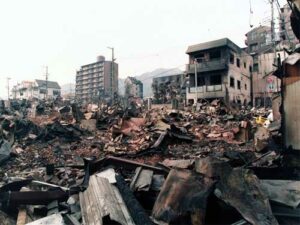Miya Smith is an Orange County, Calif., resident and member of Saddleback Church in Lake Forest. She has a brother working at the Fukushima nuclear plant. His job is to supervise a portion of the 500 men working to save and restore the plant.

“My brother is 37 years old and a civil engineer. He works for one of the major construction firms in Japan, in its Sendai branch. They do public works with TEPCO sometimes and TEPCO asked their contracting firms and suppliers to build tanks inside the power plant to store the highly radioactive waters from the damaged reactors.
Here is a portion of a letter written to Miya from her brother:
“Hi, I am fine. We came to our company branch in Iwaki city, Fukushima (little over 20 km south from the plant) yesterday and are using it as our base office.
“Yesterday’s aftershock was pretty big, even though I was used to earthquakes, it was scary. After the big aftershock, the power went out, and medium aftershocks (Japanese scale of Shindo 3-4) kept coming almost every 10 minutes.
“As for the work inside the plant, we started yesterday. It is inside the Fukushima Nuclear plant. Seeing with my own eyes the exploded and damaged reactor building No 4, I was just speechless.
“When we are working inside the plant, it is mandatory that each worker carries the Geiger counter to measure the radiation. Each worker going inside the plant to work must wear the protective suit, special mask, gloves, socks, and shoes covers inside this building called “Anti-earthquake building” and is given a Geiger counter.
“After work, each worker throws away all of the suit and equipment, and shoe covers, etc. and returns the Geiger counter. The number showing at this time is the radiation level you took in that day. My level today was 0.42 millisieverts (420 microsieverts).”
Myia explained, “(Just to put things in perspective, you will get 0.2 millisieverts for flying round-trip between Tokyo and NY. And 2.4 millisieverts in a year just by living a normal life from natural sources, and 6.9 millisieverts in just one CT scan on chest.)”
The brother then continued: “My workers and I are staying at a hotel in Iwaki-city. I can sleep normally in bed and other non-plant workers (evacuees) are also staying here. All the food is provided by the company, so I don’t have to worry about getting the food myself.
“When we go to work, we will always go through this facility called ‘J Village’ about 20 km from the power plant. They will use specially labeled vehicle so called “contaminated vehicle” to transport workers between J Village and Anti-Earthquake building inside the plant. We have to wear full protective gear just for this ride, which is disposable each time. This vehicle will never be used for other purpose nor be taken outside the radioactive area, since it is highly contaminated. Up until we go to J Village to put on the protective gear for the ride to the plant, we wear normal construction clothes.
“I can guess there are probably 1,000 people or so doing some kind of work inside the Fukushima power plant. There are many different types of jobs, some working directly to figure out the situation of the reactors and the water issues. Some are working to restore them. Some are solely for handling all the Geiger counters for the workers. Some are recording everyone’s radiation levels, some are working on power cables and restoring power, and some are removing and cleaning the debris from tsunami and explosion. Some are working to provide protective gears for the workers, changing filters for the masks, and disposing the gears. Also, some are working to provide meals inside the plant for the workers, and some are securing water for the toilet in the plant … and some are building tanks to store contaminated water (my job).
“As for the limit of radiation level for each worker, Japanese government has guidelines (set before this earthquake) that it has to be less than 100 millisieverts per year. But since this disaster, only for TEPCO employees, this limit was raised to 250 millisieverts.
“So, for us other workers (non-TEPCO employees), the limit is still 100 millisieverts. According to the safety training brochure of TEPCO, they have stats that at 500 millisieverts, some kind of health issues start to appear, and that is still mild cases.
“Yes, it is a dangerous situation, but I am doing fine, my only small complaint is that we are told to stay at the hotel even when we are not working, in case something happens and they need extra workers. ”
Please continue to follow the story of Japan. We love and pray for the people. Pray for Miya’s brother and the nuclear plant workers. Pray for Japan! –Alex Murashko, ASSIST News
Note from the author: “PEACE in Japan” is about praying and serving with the Japanese Church. The Japan PEACE Team of Saddleback Church exists to support existing partnerships and cultivate new relationships with pastors, churches, leaders and missionaries who love and serve persons of Japanese descent for the sake of Jesus Christ. The Purpose Driven Fellowship of Japan is also helping this effort. Go to http://peaceinjapan.com to follow our story.
——————————————————————————–
Alex Murashko is founder and editor of Outreach New Media. Murashko has been a reporter for the Los Angeles Times, Press-Enterprise, Christian Examiner, and ASSIST News. He is a volunteer for the Communications Department at Saddleback Church in Lake Forest, Calif.
Twitter: http://twitter.com/AlexMurashko
Facebook: http://www.facebook.com/amurashko
Email: [email protected]



